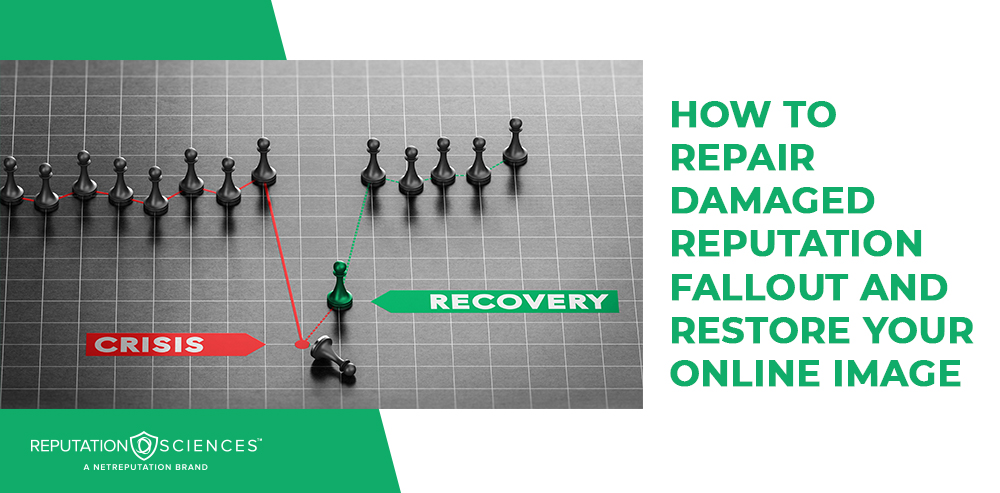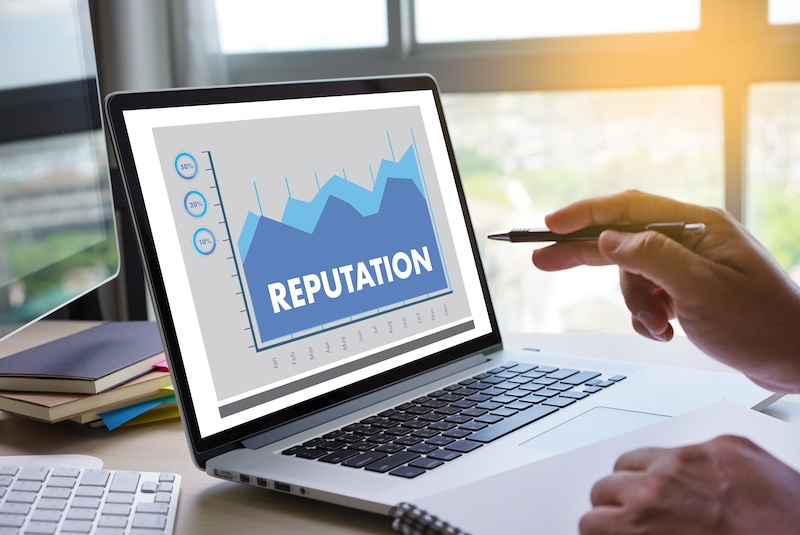How To Repair Damaged Reputation Fallout and Restore Your Online Image

In this article, we’ll explain how to repair damaged reputation consequences so you can put your professional or personal brand back in a positive light.
Regardless of the reason for your personal or professional brand’s tarnished reputation — negative online reviews, PR scandals, social media backlash, etc. — the effects can be catastrophic. Without proper reputation management, it can be nearly impossible to ever bounce back and show your audience you’re ready to do things differently.
In today’s digital age, repairing a bad reputation is crucial to your success. Information spreads fast online, and your current reputational crisis will only grow more out of control the longer you take to act.
Continue reading to learn the key strategies for repairing reputational damage and fortifying your online presence against another reputation crisis. We’ll go over short-term fixes to help you rebound fast, along with long-term reputation management techniques for ongoing success and damage control.
The way you’re perceived online matters, and a poor reputation online can damage your personal life and your professional opportunities. Find out how to restore trust and create the online reputation you deserve by calling (844) 458-6735 today.
Identify the Source of the Damage

Understanding where the bad reputation stems from will allow you to create a customized approach to repairing it and make a genuine impact.
Did an influx of bad reviews scare off potential customers? Were private, personal actions publicized and reflect poorly on you? Has an unflattering social post gone viral?
Once you’ve determined what happened to cause the damage, you’ll need to figure out why it happened so that you can ultimately repair your reputation.
Has misinformation caused customers to have unrealistic expectations, leading to their dissatisfaction with your company? Is the supposed big mistake you made in your personal life actually a misunderstanding? Did an influencer catch wind of a mistake your brand made and decide to share it with their massive following?
Before you can move forward, you need a better understanding of what happened and why it occurred. From there, you can take a proactive approach to repairing your bad reputation and the public’s sentiment rather than guessing what went wrong and hoping your solutions make an impact.
3 Common Causes of Reputation Damage
While there are many situations that can result in a poor online reputation, here are three of the most common ones:
- Ethical or Legal Issues: An arrest, legal trouble or unethical behavior that gets picked up by media outlets can cause everything from public embarrassment to brand reputation damage.
- Negative Online Reviews: Poor reviews on popular platforms like Google, Trustpilot and Yelp can damage your business’ reputation, turn away customers, and impact sales.
- Social Media Backlash: Even one complaint or negative post can quickly go viral and be shared across multiple accounts and platforms, creating a bad reputation before you know it.
From 24-hour monitoring to upscale content creation and promotion, our team of ORM experts can help you create the good reputation you deserve. Contact us at (844) 458-6735 for more information.
Evaluate the Extent of the Damage
Now that you know why the reputation fallout occurred, it’s time to figure out how much damage it caused. Here are the factors to consider when evaluating the level of harm to your online image:
- Audience: Has the negative information reached a majority of your target audience?
- Customer Retention: Have current clients or customers stopped using your business? Have they expressed concerns about what’s going on with your brand at the moment?
- Sales and Revenue: Did your sales or revenue take a dive since the incident happened?
- Search Results: Is negative content appearing on the first page and at the top of the SERPs for your name or your business name?
- Sentiment: What’s the overall online sentiment of your brand, and how does it compare to your competitors? (Sentiment analysis tools assess online conversations to determine this.)
- Social Media: Is negative social content continuing to go viral? Is it being commented on and engaged with a lot? How are your own social media profiles performing, and how are people engaging with your content?
- Website Traffic: Has website traffic dramatically changed since the incident?
Surveys can be helpful when determining what went wrong and how to repair your reputation. If a large audience is flocking to one place to learn more about what’s going on with your brand, like social media or your website, consider putting a survey there to get feedback about your reputational risk.
Craft a Professional and Thoughtful Response

Dealing with a bad reputation requires a response from the individual or brand that’s been impacted so you can begin making amends. Whether you’re replying to online reviews or you’re making a statement to the press, it’s important to be polite and professional; avoid getting confrontational or defensive, which will only damage your online credibility more.
Respond As Soon As Possible
To show that you’re accountable for your bad reputation, address the situation ASAP. You don’t have to have all the details to clarify that you’re aware of the situation and are taking action.
Take Responsibility
Regardless of who is actually at fault, it’s important that you take full responsibility for the situation. Otherwise, it’ll seem like you’re trying to get out of trouble by blaming someone else. Admit to any mistakes you made and explain what happened without making excuses.
Sincerely Apologize
Specifically address anyone impacted by the situation. Be clear and empathetic in your response, which will communicate that you truly regret what happened. Avoid a conditional apology that goes something like, “If you were affected by…” This weakens the apology and makes you sound insincere.
Share Your Solution
After apologizing, explain what you’re doing to solve the problem and prevent it from happening again. For example, will major policy changes be made? Are new training programs for employees going to be offered? Give specifics about mitigating your reputational risk, including a timeframe for when different steps will be completed.
Suppress Negative Content Online

Now that you’ve demonstrated that you’re not running away from the problem, you can start the process of rebuilding your good reputation. A cornerstone of this is creating neutral and positive content that will rank highly in search results and suppress negative content related to your name or brand.
- Consistently Post New Positive Content: By publishing fresh content daily or even several times a day, you’ll drown out the unflattering noise surrounding your brand.
- Diversify the Content You Post: To create a broad online presence, create different types of content for a variety of platforms. For example, add new and curated articles to your blog, record videos and share testimonials on YouTube, and use social media for a behind-the-scenes look at your new-and-improved brand.
- Use SEO Techniques: SEO tactics like filling out blog post and web page metadata and building backlinks can help optimized content rank fast.
- Reach Out to the Press: Engage with bloggers, influencers and journalists to encourage positive press coverage. Be transparent about the efforts you’re making to fix past mistakes.
Don’t wait — get started today with online reputation management or repair. Give us a call at (844) 458-6735 to learn more.
Engage With Your Audience

Don’t forget about the most important people in all of this: your customers. It’s important to continue to work on your relationships with clients, customers and followers to build a reputation they can trust.
- Create channels where your audience can share their concerns and feedback.
- Host a Q&A session so that customers and the public can ask you questions in real time.
- Improve your support channels and approaches so that every customer receives excellent service.
- Partner with customers, employees or influencers who will act as advocates for your brand.
- Personally respond to comments, DMs and reviews on social media and review sites.
- Send surveys to identify the areas where your business needs to improve.
- Share success stories online to highlight the customers who have a great experience with your brand.
Do you need help with your digital presence? Call us at (844) 458-6735 for an in-depth audit and valuable insights from an expert.
Monitor Your Online Presence
Whether your company has a good or bad digital presence, reputation management requires regular online monitoring. This way, you’ll be notified whenever your name or your company is mentioned online in content, including:
- Blog post articles
- Negative stories from news outlets
- Online forums like Reddit
- Podcasts, videos and other media
- Social media posts
Tools like Google Alerts or more advanced social listening software — which is often included in reputation management platforms — will “listen” for online mentions of terms you input. When you’re able to catch search engine results and social media content about you in real time, you have a much better chance of preventing problems from escalating.
Professional Reputation Management Services
Repairing your internet reputation and digital identity can be a long and drawn-out process. However, with time, dedication and an expert approach, it’s possible to reclaim that good reputation you spent so long developing in the first place.
To build a reputation you deserve, the following steps are necessary:
- Identify what caused the damage.
- Evaluate how much damage there’s been.
- Communicate clearly and thoughtfully to take responsibility.
- Leverage content creation to improve the online narrative.
- Engage with your audience to humanize your brand and improve customer service.
- Monitor your online presence 24/7.
At ReputationSciences.com, we work with clients who are ready to create, grow or repair their digital reputation. Whether you’re prioritizing your personal or professional online reputation, our team of experts and tailored services can help.
Through our parent company, NetReputation, we offer a range of ORM services, including ad management, local SEO, review monitoring, content removal and more. Our tried-and-true strategy includes auditing, repair, monitoring and management, and our services will be customized to your unique needs.
Call us at (844) 458-6735 to speak with an ORM expert today.
